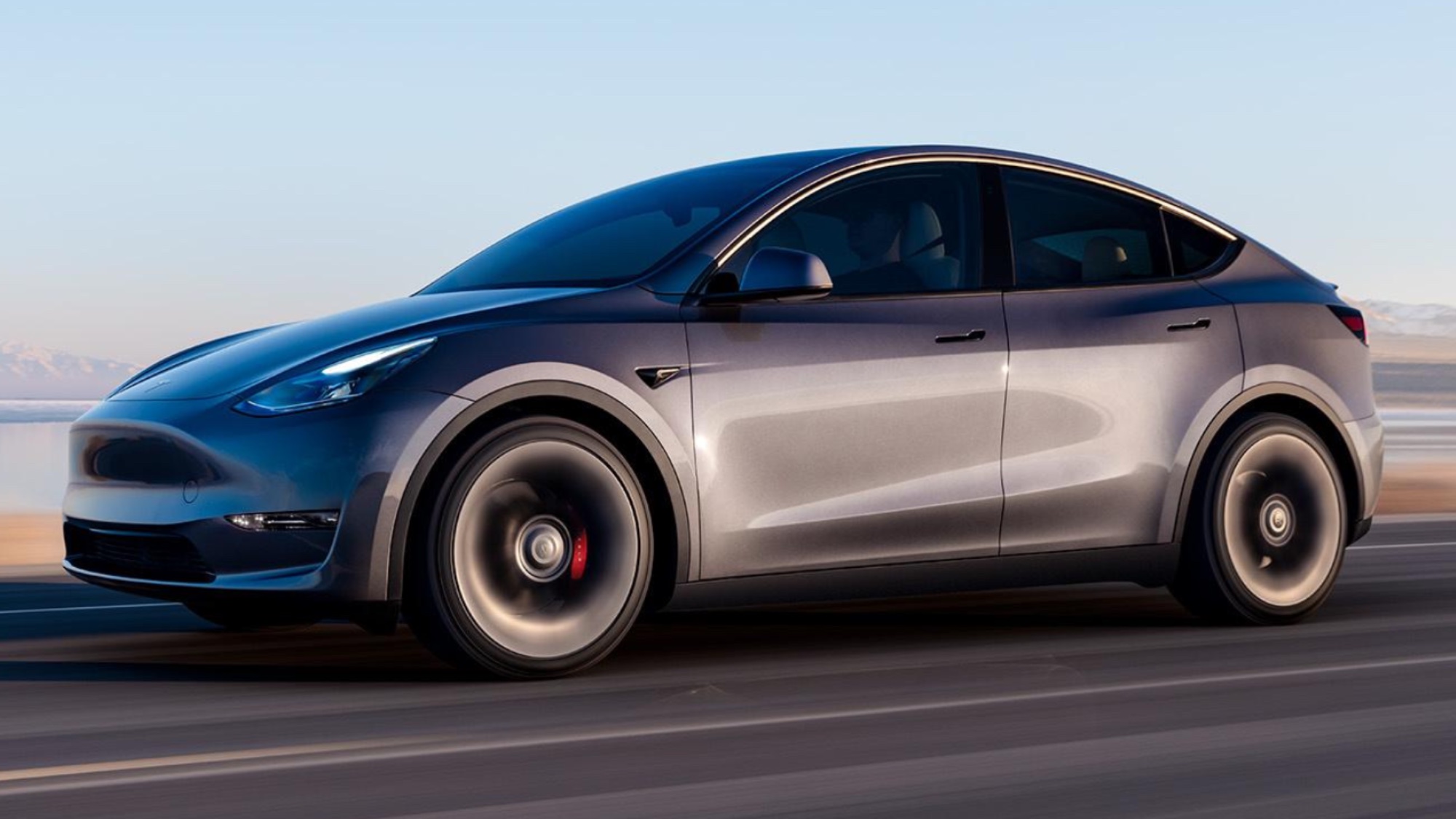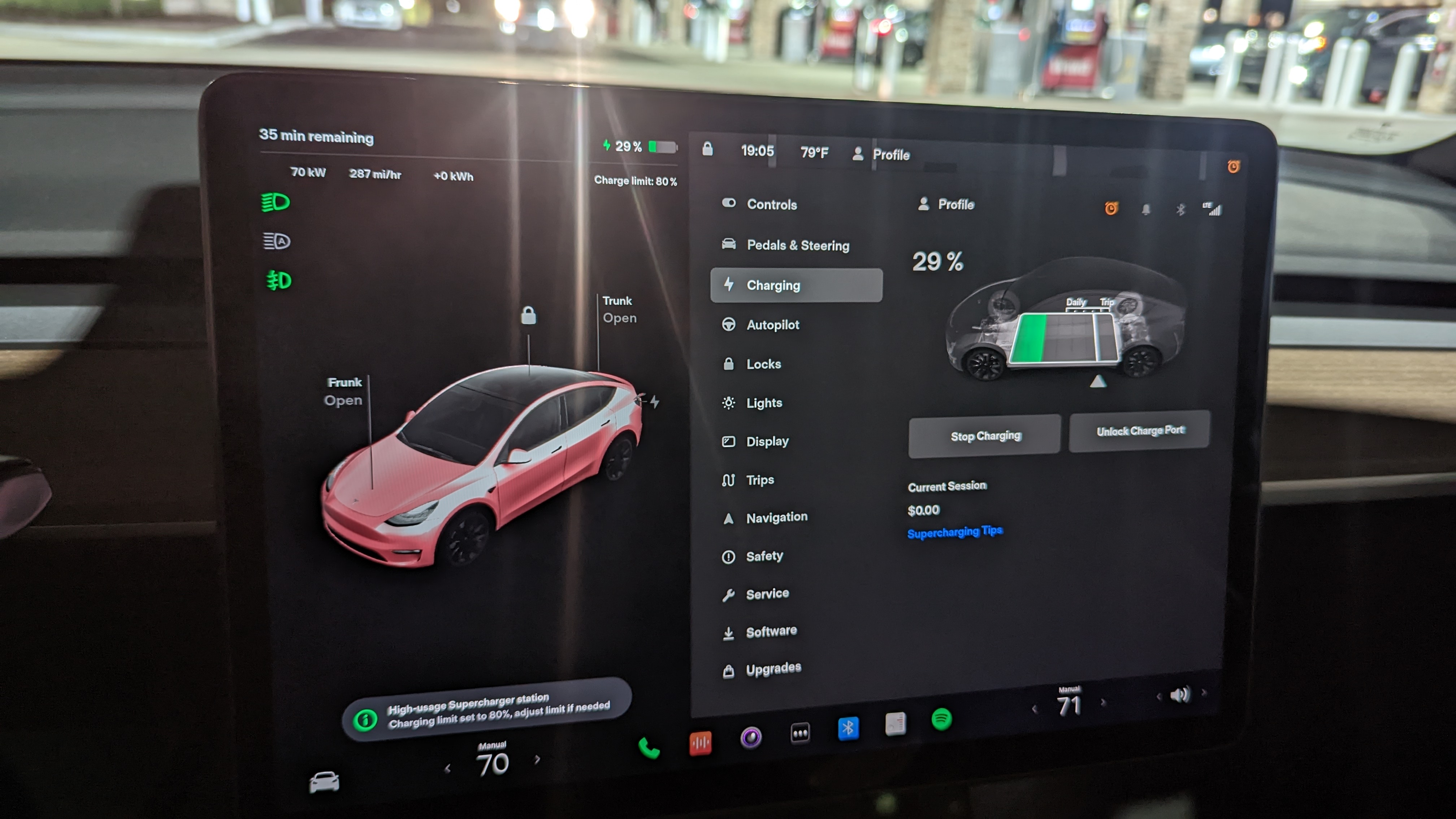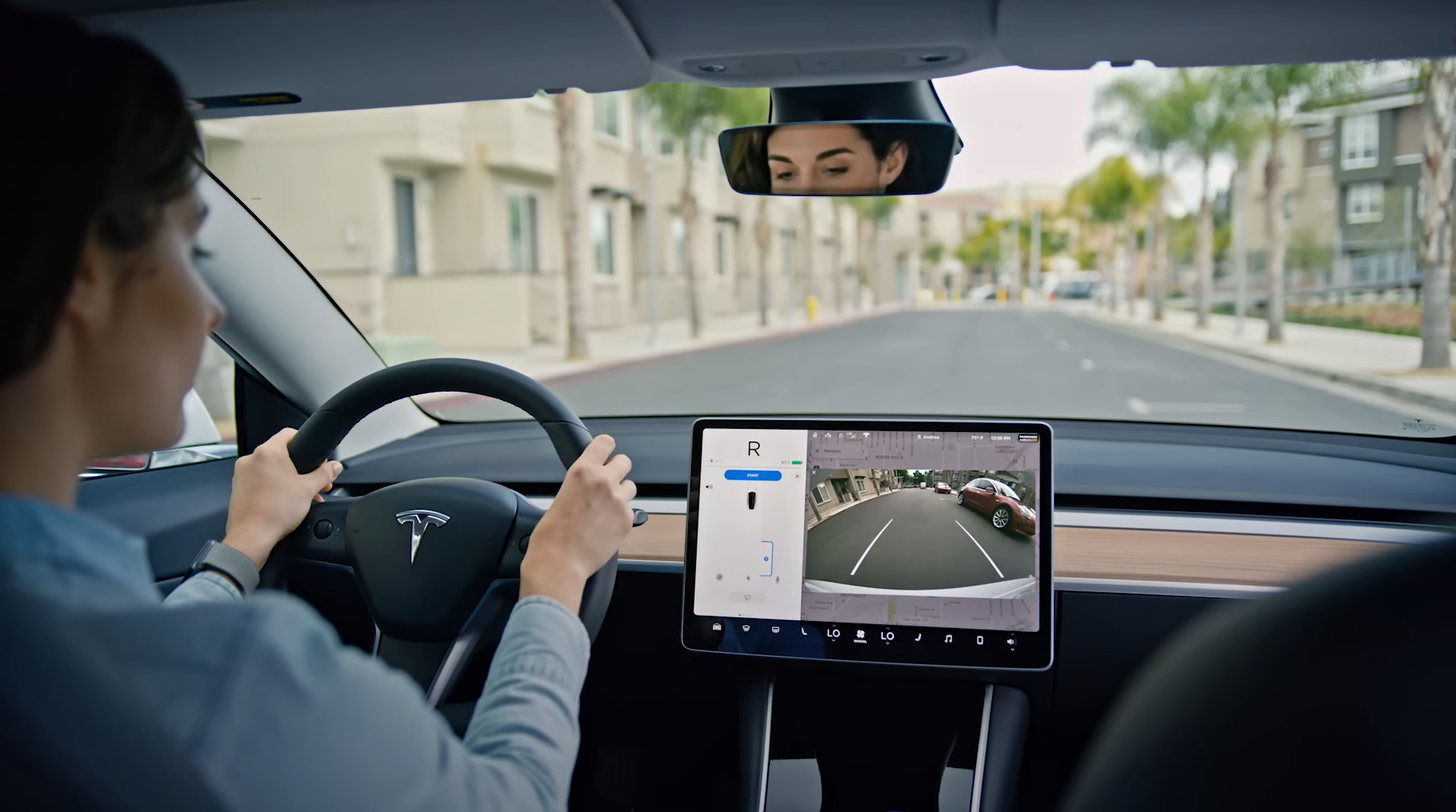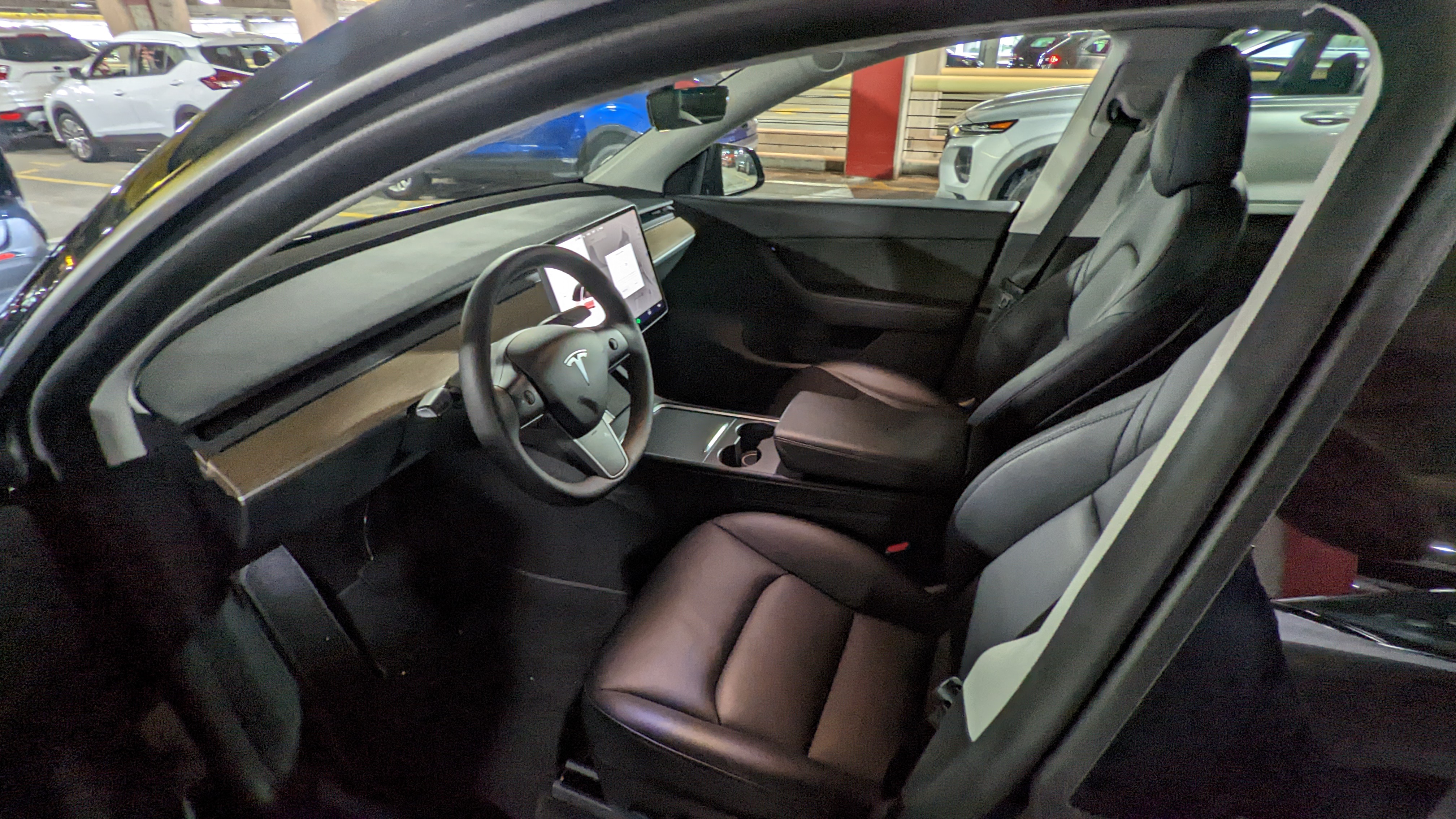I just rented a Tesla on vacation — here’s what happened
Driving a Tesla has its challenges, but not the ones you'd expect

In case you didn’t know, it’s now easier than ever to rent an electric car. Whether you’re on vacation, you need a temporary set of wheels, or whatever other reason you may have to pick up a rental, you don’t have to rely on the internal combustion engine.
That’s exactly what I did during my recent vacation, a ten-day trip to Orlando, Florida. Normally I drive a Nissan Leaf, a small but serviceable electric car, and the prospect of switching to a combustion engine vehicle didn't really appeal. Least of all because I was booking this trip around the time gasoline prices were at record highs.
Fortunately, I was able to secure myself one of the best electric cars, a Tesla Model Y, from Hertz, and for a not-so unreasonable price. I paid $101 a day and $1,010 overall, which was only around $250 more than the cheapest option available — which was some kind of compact hatchback.
With car rental companies, Hertz in particular, starting to invest more in electrified fleets, you may find yourself renting an electric car sooner rather than later. So here’s how my whole trip with a Tesla went down.
Pre-trip jitters

I’ve already spoken about this before, but the run-up to my trip did have me feeling a little anxious. The cause of that anxiety changed over the course of a couple of months, but there was one point where I had a little voice in the back of my head pestering me about charging. Which I knew was ridiculous, for a bunch of reasons. Least of all because I was staying in an area with no fewer than four Tesla Superchargers.
For someone that’s never driven an electric car before, I suspect those feelings would be considerably worse. I can’t tell you that your hypothetical future trips will all go smoothly in an EV, but what I can say is that Hertz is hell-bent on making sure people know how electric cars work before they pick them up.
In the four months between booking the car and arriving in Orlando, I got no fewer than 11 emails going over the intricacies of the Tesla Model Y, electric car driving and the whole recharging process. That’s as well as the usual waft of administrative emails detailing pick-up locations, checking in and so on.
I didn’t read a single one of those emails, to tell you the truth. I’ve already driven Teslas, know all about driving and charging electric cars, and had a deep dive into Hertz's EV-centric literature back when they announced their first plans to go electric. But that’s because my job requires it. For everyone else, provided you’re not a seasoned Tesla driver, there’s plenty to familiarize yourself with before you even get on a plane.
That said, no amount of reading is going to make you intimately familiar with the intricacies of Tesla driving. As I found out.
Getting used to driving a Tesla

Anyone that watched the first season of Good Girls may remember Dean (Matthew Lillard) referring to a Tesla as a “giant iPad”. That assessment is pretty accurate, because no matter what car you get into these days, everything is generally the same — with buttons, dials, levers and all those other things. Tesla’s extreme minimalism, on the other hand, makes it feel much more like a smartphone on wheels than an ordinary car.
Tesla’s extreme minimalism makes it feel much more like a smartphone on wheels than an ordinary car.
Everything you may want to do while in the driver’s seat, aside from actually driving, requires advanced knowledge of how things work or a deep dive into the settings menu. Setting climate control, changing the speed of the wipers, adjusting the type of headlights you’re using, and so on. There’s a fairly steep learning curve that you usually don’t get with other cars.
Case in point: actually locking the car. Arriving in the parking garage, the Tesla I rented was already unlocked. Most airport rentals are in my experience, and it means the key lives inside the car. Arriving at our hotel, I realized I didn’t know how to lock it. Being a rental I didn’t have access to the Tesla app for proximity-based locking, and there’s no button-laden keyfob to lock and unlock at will.

It’s frustrating to realize something so basic has been changed to the point where you have to use Google to figure out what you’re supposed to do. Especially after you’ve been up 16 hours, spent 10 of those hours on a plane, and the temperature is around 85 degrees.
It’s also worth noting that this is the first time I’ve driven a Tesla in the United States. That has its own challenges, on the road and inside the car. Particularly where the side mirrors are concerned — and how hilariously small they felt.
I had to do a little digging into this, because I never had that problem in a Tesla back home. Like a lot of things, it was all down to the different regulatory standards across the world. European mirrors are wider and cover a lot more of your blind spot, while American mirrors are built to offer a more realistic view behind you.
Not that I ever found this an issue the last time I was driving in the U.S., rocking around in a Ford Fiesta. Then again, I shouldn’t be too surprised that there are rubbish mirrors when Tesla’s CEO has been trying to replace them with cameras for nearly a decade. There’s a hi-tech solution to make up for it, of course, but it took me several drives to even notice that a live camera feed switches on every time you hit the turn signal.
Tesla Autopilot proved its worth

While autonomous driver assistance systems are not uncommon these days, Autopilot is still one of Tesla’s defining features. It’s also standard, and unlike other automakers it’s not exclusive to the most expensive trims. Rental Teslas are apparently no exception, though they only come with the Basic Autopilot package.
Driving on the I-4 would have been a lot more harrowing, given the sheer amount of high-speed traffic around me, had I not been able to let Autopilot keep my Tesla in the center of the lane.
Naturally, no rental company is going to shell out a minimum of $6,000 to upgrade to Enhanced Autopilot or $15K for Full Self Driving. No matter what special features might come with it. If you want to try those, you’ll have to go to a Tesla dealership for a test drive.
Driving to Disney World from where I was staying (near Universal) involved a drive between 11 and 15 miles, the majority of which was down a particularly straight section of Interstate-4. Needless to say, it was the perfect opportunity to put Autopilot to work — especially when it was getting busy.
Autopilot gave me the opportunity to fully concentrate on my surroundings, rather than worry about my speed limit and how close I am to the lane markings. Things that could have been made easier had the car come with a few simple things — including wider mirrors and a driver display behind the wheel.
I always forget how big the Tesla Model Y really is. Images on the Tesla website would have you believe it’s not that much larger than a Model 3, but that’s not the case. It’s a big car, and the uninitiated might assume it’s the Model X — Tesla’s full-size SUV.
My own Nissan Leaf is not a large car, but it’s not exactly small. Despite this, it feels dwarfed by the Model Y, which is taller, longer and (crucially) wider. Switching to a wider car always has me on edge at first, because it’s a little harder to gauge where my car is positioned. That was amplified by the fact I was driving from the left-hand side of the car for the first time in almost four years.
Naturally, the I-4 would have been a lot more harrowing, given the sheer amount of high-speed traffic around me, had I not been able to let Autopilot keep the car in the center of the lane. We may be a long way off fully-autonomous cars that can out-drive a human being in every situation, but those little advances make the driving experience all the more better.
My only complaint was that the car didn’t like the merging lanes. The fact they were so wide seemingly confused the Autopilot system, and the car kept trying to move into the middle when that’s the absolute last thing it should have been doing.
Charging was the least of my worries

No matter my, or anyone’s, thoughts on Tesla, there’s no denying that their cars offer a fantastic amount of range. Over 300 miles for most of its cars, including the Long Range Model Y I had to hand.
All in all, I ended up paying $15.17 for what little charging I did. Which isn’t bad considering I picked up the car at 98% and returned it on 23%, 278 miles of driving later.
A trip to Orlando doesn’t usually involve a lot of long distance driving, especially after I had to cancel the 112-mile round trip to Kennedy Space Center (thanks, Hurricane Nicole). I managed to clock in 278 miles of driving over the course of the 10 days. Sadly, I still had to recharge and didn’t manage to get close to the full 330 miles quoted by Tesla. But considering most of the driving was on highways and with some pretty high AC, that’s to be expected.
I only had to do a proper recharge once, followed by a minor top-up of around 15% on our last day to make sure we got to the airport. Since there was a Supercharger at the end of the street, next to the nearest gas station, the act of charging didn’t really take much time out of the trip.

This location was a semi-deliberate choice, since car charging availability was on my list of criteria when picking a hotel. All the hotels that offered their own chargers to guests were out of my price range, but staying 2-3 minutes drive from a Supercharger is the next best thing.
Though the route I had to take from the hotel parking lot was a little winding and complex. One thing I’ve noticed is that Orlando certainly hates drivers making left turns, and I had to spend a lot of time waiting at lights whenever it needed doing.
I’ll be honest, I didn’t pay any attention to the cost of charging when I was plugged in. In fact I don’t actually recall seeing the price per kWh anywhere, even on the car itself, just the total for the current charging session.
It is possible to see how much a Supercharger costs from the car’s navigation screen, but that information never entered my brain. Assuming I even saw it at all.
Unlike chargers that require you to pay there and then, either by car or via some sort of app, Tesla chargers have an automatic plug & charge system. Since each Tesla is unique, and tied to a specific account, Tesla-owned chargers automatically bill the owner. So the price isn’t that visible because Tesla must assume you will either check the navigation system or refer back to your receipt when the session is over.
Not being my car I never actually got a receipt, with Hertz (initially) footing the bill. Those costs are naturally passed onto the driver — and the company has promised not to add any markup of their own.

All in all, I ended up paying $15.17 for what little charging I did. Which isn’t bad considering I picked up the car at 98% and returned it on 23%, 278 miles of driving later. My estimate is that even if I had gone to Cape Canaveral, as I had originally planned, I wouldn’t have had to pay more than double that price.
Of course if you’d rather pay as you charge, and don’t mind waiting around for a slower charging session, there was a J1772 adapter in the trunk for use with non-Tesla AC chargers. I didn’t bother with that, given how little I had to recharge and how close the Supercharger actually was.
Oh, and the fact that there’s no fuel in the car means you don’t have to return it with a full tank. Hertz simply asks that it be returned with at least 10% of its battery, letting you walk away without worrying about being billed again.
I didn't quite get the full Tesla experience

Remember how I likened the Model Y to a big iPad? Because the Tesla has so much hidden away in the central touchscreen, there’s an adjustment period to try and figure out what’s hiding away in the depths of various menus.
If you own or lease the car, then you have an incentive to go for a deep dive and find all the various features and settings that are right for you — though even then you’ll miss stuff. If you’re in a rental Tesla, and only have the car for a brief period, there’s little incentive to do that. So long as you can safely drive it around for the duration of your trip.
I did go into the settings, ever so briefly, but that was primarily to increase the strength of the regenerative braking system. I’m used to using a one-pedal driving system at home, and I already knew the Model Y could do the same. Once that was done I barely looked at the settings for the rest of the trip, only doing a cursory glance round while I was waiting for the car to charge.

Similarly, because it’s not your car, you can’t hook it into the Tesla app and all the features that it has to offer — like proximity locking, remote access and so on. Remotely setting the climate control, or locating the car, would have been a huge help. Florida weather is not particularly comfortable, even in November, and locating a black SUV in a giant parking lot full of black trucks and SUVs is no easy task.
Then again, the same is true of most rentals. You may get to drive it around for the duration of your trip, but you don’t quite get the feel of what it’s like to actually own one.
Bottom line

If you’re not familiar with electric cars, then renting one is more like an extended test drive than anything else. It’s not the full picture of what you can or can’t do, but it’s a good look at what would be involved if you bought an EV for yourself.
For me, I certainly have no regrets about renting a Tesla over some other car. It was not the cheapest available option, but it meant I could still enjoy all the great benefits of an electric vehicle. Not to mention all the hi-tech options like Autopilot, which made the long stretches of road considerably easier to handle.
Plus, I could be safe in the knowledge that I wasn’t burning any gasoline to get around, nor was I at the mercy of the local gas prices. You couldn’t say the same for a Ford Focus or some equally small car a rental company would have on offer.
Read Next: Why I'd never buy a Tesla
Sign up to get the BEST of Tom's Guide direct to your inbox.
Get instant access to breaking news, the hottest reviews, great deals and helpful tips.

Tom is the Tom's Guide's UK Phones Editor, tackling the latest smartphone news and vocally expressing his opinions about upcoming features or changes. It's long way from his days as editor of Gizmodo UK, when pretty much everything was on the table. He’s usually found trying to squeeze another giant Lego set onto the shelf, draining very large cups of coffee, or complaining about how terrible his Smart TV is.
